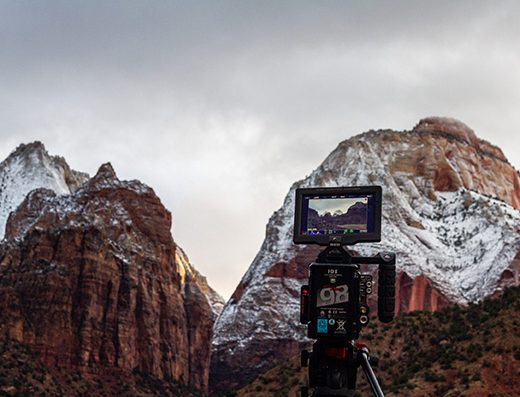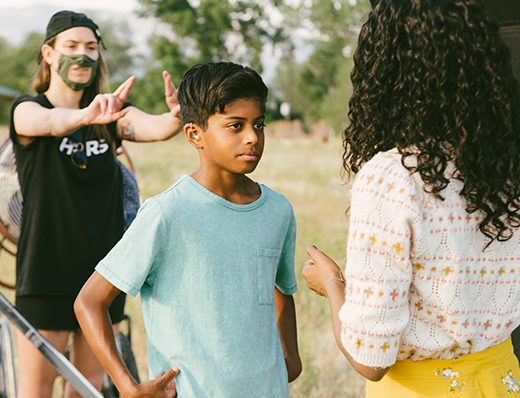Set Safety with Firearms
Nov 3, 2021

From the set of 'Murder Among the Mormons' (2021) / Netflix
In light of the tragic loss of Director of Photography Halyna Hutchins on a set in New Mexico, we wanted to revisit the importance of set safety with firearms. While set safety is often attributed to the AD and the Key Grip’s responsibilities, safety should be the concern of everyone on set.
To help crew better understand what it means to be safe with firearms on set, we asked Steve Parker — an experienced Armorer in the Utah film industry to share his insights and four simple rules to follow when working with firearms.
The late Lt. Col. Jeff Cooper is credited with four firearm safety rules that everyone who handles a firearm must know and live by. All professional armorers or firearms instructors use these exact same rules to keep everyone safe on the set or the range. The beauty of these four rules is that you must break more than one of them before you find yourself in a dangerous situation.
Firearms cannot fire by themselves. A loaded firearm laying on the table cannot hurt anyone until it has been touched or picked up. Firearms can be dangerous, as Jeff Cooper said “if they were not dangerous they would be useless to us”. A movie prop gun is usually a real gun modified to fire blanks. A blank firing prop is still dangerous because it has explosive powder in the cartridge but no bullet. Each time you fire a blank, it’s a small controlled explosion with fire and flame flying out the barrel that can travel approximately 20 feet. A movie prop semi-automatic pistol will fire with each pull of the trigger until the blank ammunition is exhausted. This requires that the barrel is modified with a partial plug so the burning powder will generate enough gas pressure to cycle the prop or load the next blank. If you loaded a real bullet in a semi-automatic prop gun, it would explode like a small grenade. This is why movie prop guns are so expensive because you have to destroy the real gun to fire blanks so it can never fire a real bullet. In the case of a movie prop revolver, this conversion is not necessary to fire blanks because a revolver must be cocked by pulling back the hammer or squeezing the trigger for the next shot. A revolver can be a little more dangerous on set because the revolver can still fire a real bullet. A revolver must be checked for any barrel obstruction before loading blanks so that any obstruction will not be blown out of the barrel by firing the blank.

Photos courtesy of Steve Parker during the filming of Murder Among the Mormons (2020)

There are four simple rules that apply to all firearms. Short of a mechanical failure, if you live by these rules you will never have a dangerous unintentional discharge on the set.
#1. All guns are always loaded.
If you treat all guns as if they are loaded, you are less likely to do foolish or stupid things with them. You must check the gun yourself and if you don’t know how, then you shouldn’t be handling the gun.
#2. Never point the muzzle at anything you’re not willing to destroy.
With handguns it is very easy to cross someone with the muzzle. On a one way range we call this “breaking the 180” and doing so will have you excused from the range. You must think of the muzzle as a red laser and pointing it at someone or some thing you don’t want to shoot is breaking the rules.
#3. Keep your finger outside the trigger guard until your sights are on target.
It’s completely natural to put your finger on the trigger and doing so tells everyone you have not been trained in the use of firearms. Someone trained to use firearms will have their trigger finger straight along the side of the firearm, not touching the trigger.
#4. Know your target and what is behind it.
On the range, this is very easy because we have a dirt berm or backstop. On set, this is difficult because if you are shooting blanks at the camera, you still have crew nearby. Special precautions should be taken, such as a remote camera or a safety visor for the crew to keep everyone safe.
We know that firearms can be deadly, therefore you must treat all firearms with the respect they deserve. This means that being complacent is dangerous and one simple mistake could lead to serious injury or even death. We don’t need more rules to be safe, we need experience and common sense. I promise you that if you will implement these four rules, you will never have an unintentional discharge and be the cause of a dangerous situation on set.
Steve Parker is a retired Deputy Sheriff with 26 years in law enforcement and has worked part time at the local gun store for 30 years. He always wanted a job that would pay him to play with firearms. He is a Firearms instructor, Patrol rifle instructor, Range Master, Life member of the NRA, Life member of USPSA and holds two certifications in Real Estate as a CSM and CPM. Steve loves spending time in the mountains with his family and lives outside Salt Lake City, UT.
To find information about armorers in the Utah film industry, visit our Utah Film Directory.
This article has been slightly edited and condensed for clarity.


